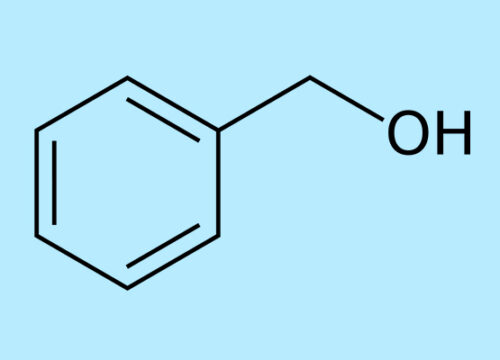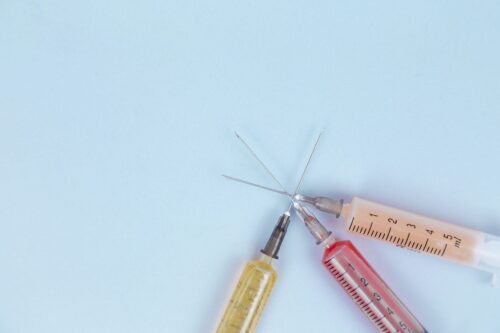Benzyl Alcohol, CAS No. 100-51-6 is an aromatic primary alcohol with the molecular formula C7H8O. It is a clear, oily liquid with a mild, pleasant odor. Benzyl Alcohol is soluble in water and readily soluble in alcohol and ether. Benzyl Alcohol is useful as a solvent and as a local anesthetic in the medical field. Pharmaceutical grade benzyl alcohol is used as a bacteriostatic and as a local anesthetic. Benzyl alcohol readily forms esters with various acids making it useful for a broad spectrum of product applications which includes production of soap, perfume, flavor & fragrance, as well as a food additive.
Benzyl Alcohol
COMPETITIVE ANALYSIS
Malhotra Organic Benzyl Alcohol
Competitive Manufacturer Benzyl Alcohol
Benzaldehyde Content(Less Than 100 PPM )
Chlorinated Compounds(Less Than 50 PPM)
Purity by HPLC
Solubility (1:25)
Endotoxins and Microbial Contamination Testing
Toluene (Not Detected)
Moisture Free
Validated Manufacturing Process
Shelf Life (> 36 Months)
| Malhotra Organic Benzyl Alcohol | Competitive Manufacturer Benzyl Alcohol | |
| Benzaldehyde Content (Less Than 100 PPM ) | X | |
| Chlorinated Compounds (Less Than 50 PPM) | X | |
| Purity by HPLC | X | |
| Solubility (1:25) | X | |
| Endotoxins and Microbial Contamination Testing | X | |
| Toluene (Not Detected) | X | |
| Moisture Free | X | |
| Validated Manufacturing Process | X | |
| Shelf Life (> 36 Months) | X |
BENZYL ALCOHOL AS A PRESERVATIVE
Oral Dosage
- Tablet Coating
- Liquids & Suspensions
- Cough Syrups
INJECTABLES
- Human Care
- Critical Care Steroids & Hormones
- Veterinary
- Bio-cultures
TOPICALS
- Ointments
- Paste
- Creams
- Gels
- Benzyl alcohol is used as a general solvent for inks, waxes, shellacs, paints, lacquers,dyeing polyamide and epoxy resin coatings. Thus it can be used in paint strippers, especially when combined with compatible viscosity enhancers to encourage the mixture to cling to painted surfaces.
- Benzyl alcohol is an ingredient used in the manufacture of soaps, topical creams, skin lotions, shampoos, and facial cleansers and is popular due to its anti-bacterial and anti-fungal properties.
- Benzyl alcohol has a variety of uses in the manufacture of other benzyl compounds, as a pharmaceutic aid, in the making of perfume, and for manufacturing flavoring for the food industry.
- When applied to damaged skin or mucous membranes at a 10% concentration Benzyl Alcohol acts as a local anesthetic and antimicrobial agent, and is sometimes included as a degreaser in rug cleaning products
- Benzyl alcohol is used effectively for treating lice infestations as the active ingredient in lotion shampoo with 5% benzyl alcohol. The use of benzyl alcohol as a 5% solution has been approved by the U.S. FDA for the treatment of head lice in children older than 6 months and in adults. It affects the louse’s spiracles, preventing them from closing. These then become clogged with water or mineral oil or other matter and cause the insect to die from asphyxiation.
- Benzyl alcohol is used as a bacteriostatic preservative at low concentration in intravenous medications, cosmetics and topical drugs.
- Benzyl Alcohol is a precursor to a variety of esters, used in the soap, perfume, and flavor industries.
- Benzyl alcohol has been used as a dielectric solvent for the dielectrophoretic reconfiguration of nanowires.
- Benzyl alcohol has nearly the same refraction index as quartz and wool fiber. If a clear quartz object is immersed in benzyl alcohol, it becomes almost invisible. This test has been used to determine non-destructively whether an object is truly made of quartz. Similarly, white wool immersed in benzyl alcohol also becomes almost invisible clearly revealing contaminants such as dark and medullated fibers and vegetable matter.
- As a dye solvent, it enhances the process of dying wool, nylon, and leather. It also has use as a photographic developer, and as an insect repellent.
- Benzyl Alcohol is used in e-liquid for e-cigarettes to enhance the flavors used.
| Product Name | Benzyl Alcohol |
| Chemical Formula | C6H5CH2OH |
| IUPAC Name | Phenylmethanol |
| Synonym | alpha-Hydroxytoluene; alpha-Toluenol; Benzal alcohol; Benzenecarbinol; Benzenemethanol; Benzoyl alcohol; Hydroxytoluene; Methanol, phenyl-; Phenolcarbinol; Phenylcarbinol; Phenylmethanol; Phenylmethyl alcohol |
| Physical state and appearance | Liquid |
| Odor | Aromatic (Slight) |
| Taste | Sharp burning |
| Molecular Weight | 108.14 g/mole |
| Color | Colorless, Clear |
| Boiling Point | 205.3°C (401.5°F) |
| Melting Point | -15.2°C (4.6°F) |
| Critical Temperature | 441.85°C (827.3°F) |
| Specific Gravity | 1.04 |
| Vapor Density | 3.72 |
| Odor threshold | 5.5 ppm |
| Auto-Ignition Temperature | 436°C (816.8°F) |
| Flash PointsProduct Name | CLOSED CUP: 93°C (199.4°F) OPEN CUP: 100.56°C (213°F) |
| Solubility | Soluble in diethyl ether, acetone. Partially soluble in cold water. Soluble in ethanol. Solubility in Benzene: > 10% Solubility in Water: 35,000 mg/l @ 20 deg. C; 42,900 mg/l @ 25 deg. C. |
| Potential Chronic Health Effects | Slightly hazardous in case of skin contact (sensitizer). CARCINOGENIC EFFECTS: Not available. MUTAGENIC EFFECTS: Mutagenic for bacteria and/or yeast. TERATOGENIC EFFECTS: Not available. DEVELOPMENTAL TOXICITY: Not available. The substance may be toxic to liver, central nervous system (CNS). Repeated or prolonged exposure to the substance can produce target organs damage. |
| Corrosivity | Non-corrosive in presence of glass |
| Stability | The product is stable |
| Special Remarks on Reactivity | Benzyl alcohol contaminated with 1.4% hydrogen bromide and 1.2% of dissolved iron (II) polymerizes exothermally above 100 deg. C. Benzyl alcohol can extract and dissolve polystyrene plastic and may attack other plastics. Incompatible with aluminum, iron, steel. |
| Polymerization | Will not occur. |
| Precautions | Keep away from heat. Keep away from sources of ignition. Ground all equipment containing material. Do not ingest. Do not breathe gas/fumes/ vapor/spray. Wear suitable protective clothing. In case of insufficient ventilation, wear suitable respiratory equipment. If ingested, seek medical advice immediately and show the container or the label. Avoid contact with skin and eyes. Keep away from incompatibles such as oxidizing agents, acids. |
| Storage | Keep container in a cool, well-ventilated area. Keep container tightly closed and sealed until ready for use. Avoid all possible sources of ignition (spark or flame). Sensitive to light. Store in light-resistant containers. |
Meets NF/EP/BP/IP/JP Monographs
| TEST | MONO-GRAPH | SPECIFICATION | TYPICAL RESULT |
| Assay | NF/EP/BP/JP | 98.0% - 100.5% of C7H8O | 99% |
| Identification – Infrared Absorption | NF/EP/JP/BP | Conforms to Reference Spectrum | Conforms |
| Appearance of Solution | EP/BP/JP | Clear and Colorless | Pass |
| Clarity of Solution | NF/JP | Test Solution shows same clarity as that of water, or its opalescence is not more pronounced than that of Reference suspension 1 | Pass |
| Color of Solution | NF/JP | The Test solution has the color of water | Pass |
| Solubility | EP/BP/JP/BP | Soluble in water, miscible with ethanol and with fatty and essential oils | Pass |
| Specific Gravity/Relative Density | JP EP/BP | 1.043 – 1.049@ 20oC | 1.047 |
| Refractive Index | NF/JP/EP/BP | 1.538 – 1.541 @ 20oC | 1.540 |
| Acidity Purity 2 - Acidity | NF/EP/BP JP | NMT 1.0mL of 0.10N NaOH solution is consumed Red color develops | Conforms |
| Inorganic Impurities - Fats and Fixed Oils Purity 4 – Peroxide Value | NF EP/BP/JP | NMT 5 | Conforms |
| Inorganic Impurities: Residue on Evaporation | NF/EP/BP/JP | NMT 0.05% | <0.01% |
| Organic Impurities - Benzaldehyde and Other Related Substances Related Substances Purity 3 – Benzaldehyde and other related substances | NF EP/BP JP |
Benzaldehyde-0.05% max. Cyclohexylmethanol-0.10% max. Peaks with RT < C7H8O-0.02% max. Peaks with RT > C7H8O-0.20% max. |
<0.01% <0.001% <0.01% <0.001% |




